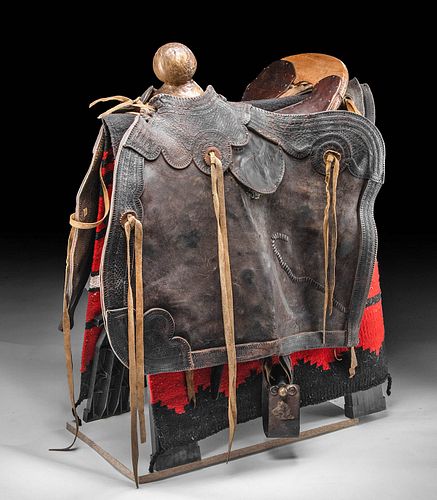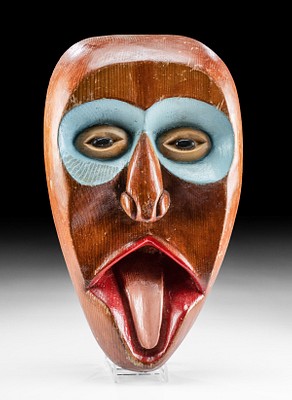1920s Mexican Wood & Tooled Leather Charro Saddle
Lot 209
About Seller
Artemis Gallery
686 S Taylor Ave, Ste 106
Louisville, CO 80027
United States
Selling antiquities, ancient and ethnographic art online since 1993, Artemis Gallery specializes in Classical Antiquities (Egyptian, Greek, Roman, Near Eastern), Asian, Pre-Columbian, African / Tribal / Oceanographic art. Our extensive inventory includes pottery, stone, metal, wood, glass and textil...Read more
Categories
Estimate:
$1,500 - $2,250
Absentee vs Live bid
Two ways to bid:
- Leave a max absentee bid and the platform will bid on your behalf up to your maximum bid during the live auction.
- Bid live during the auction and your bids will be submitted real-time to the auctioneer.
Bid Increments
| Price | Bid Increment |
|---|---|
| $0 | $25 |
| $300 | $50 |
| $1,000 | $100 |
| $2,000 | $250 |
| $5,000 | $500 |
| $10,000 | $1,000 |
| $20,000 | $2,500 |
| $50,000 | $5,000 |
| $100,000 | $10,000 |
| $200,000 | $20,000 |
About Auction
By Artemis Gallery
Sep 9, 2021
Set Reminder
2021-09-09 10:00:00
2021-09-09 10:00:00
America/New_York
Bidsquare
Bidsquare : Art & Artifacts of North America
https://www.bidsquare.com/auctions/artemis-gallery/art-artifacts-of-north-america-7436
Join us for a special auction not to be missed! Collectible Native American art from antiquity to mid-20th century, Spanish Colonial, Latin American, fine & folk art, American frontier items, and much more! Artemis Gallery info@artemisgallery.com
Join us for a special auction not to be missed! Collectible Native American art from antiquity to mid-20th century, Spanish Colonial, Latin American, fine & folk art, American frontier items, and much more! Artemis Gallery info@artemisgallery.com
- Lot Description
Latin America, Mexico, ca. 1920s CE. A western style and ornately tooled leather charro wooden saddle with tooled leather covers, brass conchos, and iron fittings. One stirrup is hand carved from wood, while the other is cast iron with an applique horse head ornament! The seat, known as the tree or base, is carved from wood with an open center. The wood is covered with leather seat panels. This charro form developed from Spanish saddles, with horns added by Mexican riders for lasso use. Under the tree are two layers of leather skirts, and leather ties with brass conchos are secured along the skirt. The massive leather panels are connected by cords and rest around the horn. Everything on this saddle displays great signs of use and makeshift adjustments when parts needed replacement! Size of one leather cover panel: 29" L x 23.5" W (73.7 cm x 59.7 cm); the wood seat: 15" L x 12" W (38.1 cm x 30.5 cm)
Charro saddles differ from western American types, with a bigger seat and horn, using leather cords to stitch the panels together. The charro is a traditional Mexican horseman, the result of hundreds of years of blended indigenous and Spanish Colonial culture. After the conquest of Mexico, the Viceroyalty of New Spain prohibited indigenous people from riding or using horses aside from certain elite members of indigenous groups that had allied with the Spanish. However, as cattle became an important part of the Mexican economy, landowners needed horse riders to manage their herds. Farmers hired mestizo cowboys, who had to obey several laws in order to be allowed to ride a horse, including that they had to use a saddle different from that used by the Spanish military. From these first riders, horse riding grew in popularity, especially after the Mexican War of Independence (1810-1821). After the war, Mexico was in chaos, and some horsemen began dressing themselves in silver-adorned finery and dressing in the distinctive clothing of "charros" - elite horse riders with large sombreros, tight trousers, and embroidered jackets. Towards the end of the 19th century, President Benito Juarez established a group of mounted police known as the "rurales" to establish order in the countryside, and they drew upon the look and style of the "charros," coming to symbolize national unity, strength, and the ideal of Mexican manhood. Perhaps the most famous charro is General Emiliano Zapata. Today, the charro lives on in the national sport of Mexico, the "charreada" or Mexican rodeo.
Provenance: ex-Austin Auctions, Austin, Texas, USA
All items legal to buy/sell under U.S. Statute covering cultural patrimony Code 2600, CHAPTER 14, and are guaranteed to be as described or your money back.
A Certificate of Authenticity will accompany all winning bids.
PLEASE NOTE: Due to recent increases of shipments being seized by Australian & German customs (even for items with pre-UNESCO provenance), we will no longer ship most antiquities and ancient Chinese art to Australia & Germany. For categories of items that are acceptable to ship to Australia or Germany, please contact us directly or work with your local customs brokerage firm.
Display stands not described as included/custom in the item description are for photography purposes only and will not be included with the item upon shipping.
#163754Newer repairs with adhesive to circular piece on top of larger panel - this adhesive is starting to come apart in this area. Old repair to leather saddle cover panel with large leather stitching. Cracking, flaking, and losses to leather areas throughout. Fraying to stirrup straps. Not recommended for sitting on. Stirrups are mismatched - one is metal and the other is wood. Both are attached with older wires and additional leather pieces. Chips to wooden pommel, but lustrous with patina, as is the wooden seat and leather covering. Patina to all metal pieces. Overall good condition.Condition
- Shipping Info
-
All shipping is handled in-house for your convenience. Your invoice from Artemis Gallery will include shipping calculation instructions. If in doubt, please inquire BEFORE bidding for estimated shipping costs for individual items.
-
- Buyer's Premium



 EUR
EUR CAD
CAD AUD
AUD GBP
GBP MXN
MXN HKD
HKD CNY
CNY MYR
MYR SEK
SEK SGD
SGD CHF
CHF THB
THB
















